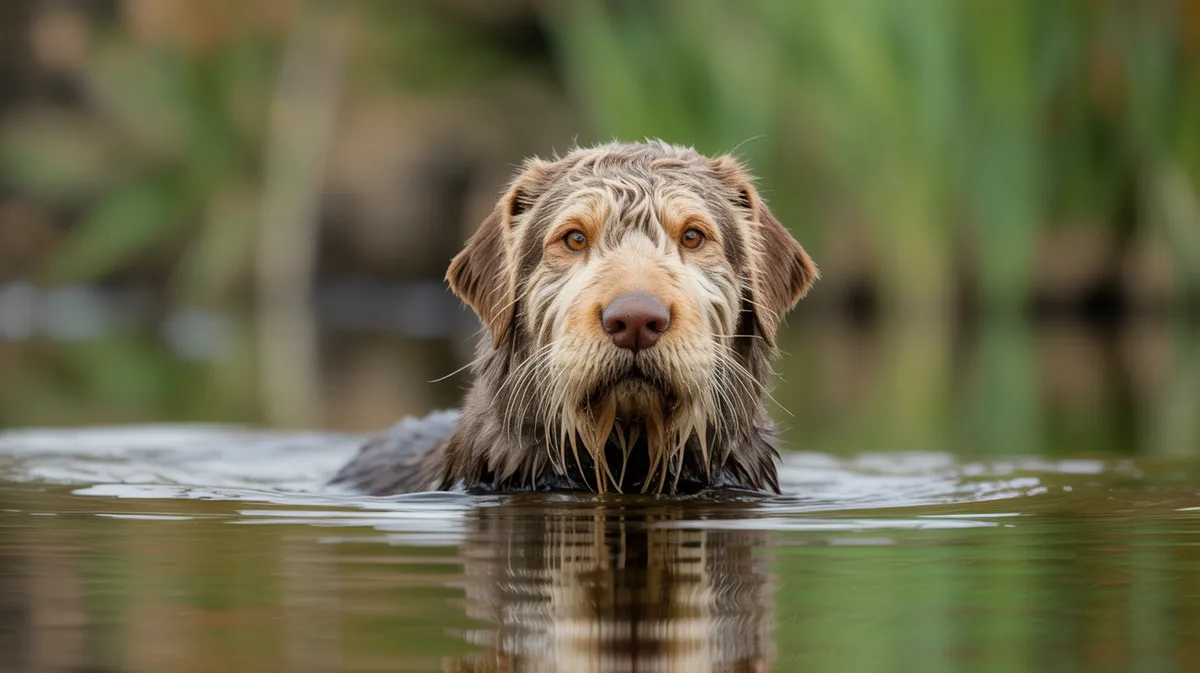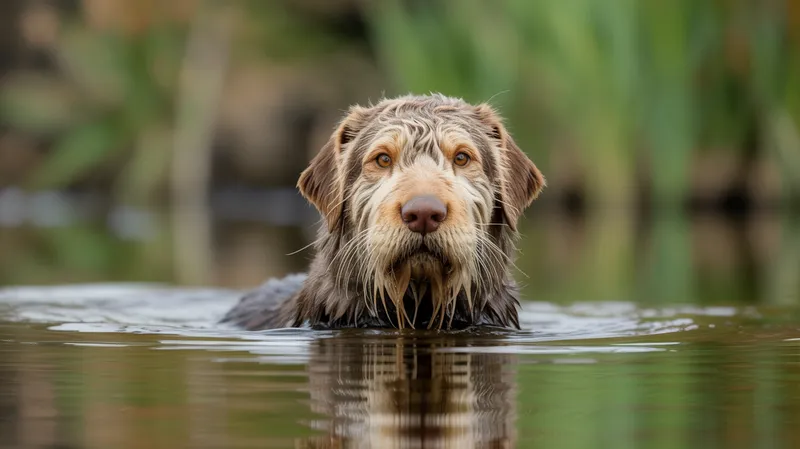
Otterhound
Canis lupus familiaris

Meet the Otterhound
The Otterhound is a large, rough-coated scent hound originally bred in England for otter hunting. Characterized by its dense, waterproof double coat, webbed feet, and keen nose, the Otterhound is an energetic and friendly dog well-adapted to aquatic environments. This rare breed is sociable, intelligent, and known for its deep, melodious voice. With a playful yet independent personality, Otterhounds make loyal companions but require ample exercise and mental stimulation. Due to the decline in otter hunting and low breed numbers, Otterhounds are now considered one of the rarest dog breeds in the world.
Classification
Mammal
Habitat
Freshwater rivers, streams, and rural countryside
Diet
Carnivore
Lifespan
10-13 years
Conservation
Vulnerable
Weight
30-54 kg (66-120 lbs)
📖Fascinating Facts
Super Sniffers
Otterhounds have one of the most sensitive noses among all dog breeds, able to follow scent trails even underwater for long distances.
Natural Swimmers
Thanks to their webbed feet and strong, muscular bodies, Otterhounds are expert swimmers, originally used to hunt otters in rivers and streams.
Distinctive Bay
The Otterhound is known for its deep, resonant bay, which can be heard over long distances and was useful for hunters tracking the pack.
📋Detailed Description
The Otterhound is a large, powerfully built scent hound, typically weighing between 36–52 kg (80–115 lb) and standing 61–69 cm (24–27 in) at the shoulder, with males generally larger than females. Its most distinctive anatomical features include a broad, domed head, deep chest, strong, muscular limbs, and large, webbed feet, all of which contribute to its exceptional swimming ability. The breed's double coat consists of a dense, woolly undercoat and a harsh, oily, water-resistant outer coat, providing insulation and buoyancy in cold aquatic environments. Otterhounds possess a highly developed sense of smell, with an estimated 100 million scent receptors, enabling them to track otter trails over water and land for distances exceeding 20 km (12 miles). Their ears are long, pendulous, and covered with hair, helping to funnel scent particles toward the nose. Behaviorally, Otterhounds are known for their deep, resonant baying voice, which was historically used to communicate during hunts. They are intelligent, independent thinkers, often displaying a stubborn streak, but are also affectionate, sociable, and gentle with humans and other dogs. The breed has a slow rate of physical and mental maturation, often retaining puppy-like exuberance well into adulthood. Otterhounds are generally healthy but are predisposed to certain hereditary conditions, including hip dysplasia and epilepsy. Their life expectancy averages around 10 years, with some individuals living longer under optimal care.
💡 Did you know?
Fewer than 1,000 Otterhounds are estimated to exist worldwide, making them rarer than giant pandas.
🔬Research & Sources
Wikipedia Summary
The Otterhound is an English dog breed. It is a scent hound and is currently recognised by the Kennel Club as a Vulnerable Native Breed with around 600 animals worldwide.
Last Modified: 1/4/2025
🎭Behavior & Social Structure
Otterhounds are highly active and inquisitive, requiring significant daily exercise and mental stimulation to prevent boredom-related behaviors. Historically, they worked in packs, displaying strong social bonds and cooperative hunting strategies. Their pack-oriented nature translates into a generally amiable disposition toward other dogs and people, though they may be reserved with strangers. Otterhounds use their acute sense of smell to track scents both on land and in water, often following a trail with single-minded determination for hours. They are natural swimmers, frequently seeking out water and displaying playful, sometimes boisterous, behavior during aquatic activities. Feeding behavior is typical of large hounds, with a tendency toward food motivation and occasional scavenging. Otterhounds are vocal, using a deep, melodious bay to communicate excitement, alertness, or the presence of a scent trail. Daily routines should include long walks, opportunities for swimming, and scent-based games to satisfy their working instincts.
👶Reproduction & Life Cycle
Otterhounds are monoestrous, with females typically coming into heat once or twice per year. The breed is known for relatively small litter sizes, averaging 6–8 puppies, which contributes to its rarity. The gestation period is approximately 63 days. Breeding is often carefully managed by breed clubs and conservationists to maintain genetic diversity and minimize inherited health issues. Parental care is primarily provided by the dam, who nurses and protects the puppies for the first 6–8 weeks. Puppies are born blind and deaf, opening their eyes at around 10–14 days. Socialization with humans and other dogs is crucial during the early developmental period to ensure stable temperaments. Responsible breeders often delay breeding until females are at least two years old to ensure physical and behavioral maturity.
🛡️Adaptations & Survival
The Otterhound's most notable adaptations are its webbed feet and oily, water-resistant double coat, both of which are specialized for swimming and working in cold, fast-flowing rivers. The webbing between the toes increases surface area, providing powerful propulsion in water. The breed's large, capacious lungs and deep chest support endurance swimming and scent trailing over long distances. Their highly developed olfactory system is among the most sensitive in the canine world, allowing them to detect faint aquatic scent trails left by otters and other semi-aquatic prey. The loose, shaggy skin and thick coat protect against bites and abrasions from undergrowth and cold water. Behaviorally, their independence and problem-solving skills are evolutionary traits selected for working autonomously or in packs over challenging terrain and in complex scent environments.
🎨Cultural Significance
The Otterhound has a rich cultural heritage in Britain, where it was developed in the Middle Ages specifically for otter hunting—a practice aimed at protecting fish stocks in rivers and ponds. Otter hunting was a popular sport among the British aristocracy from the 12th to the early 20th century, and Otterhounds were prized for their stamina, scenting ability, and aquatic skills. The breed is occasionally referenced in British literature and art as a symbol of rural sporting life. With the decline of otter hunting and the rise of wildlife conservation, the Otterhound's role shifted from working dog to companion animal and show dog. Today, it serves as a living link to traditional countryside practices and is celebrated by enthusiasts for its unique history and endearing personality.
🔬Recent Research & Discoveries
Recent genetic studies have focused on the Otterhound's limited genetic diversity, using genome-wide analyses to inform breeding strategies and reduce the risk of inherited diseases. Ongoing research by the UK Kennel Club and international breed clubs includes health surveys, pedigree analysis, and the development of DNA tests for known hereditary conditions. Veterinary studies have documented the breed's predisposition to orthopedic and neurological disorders, prompting recommendations for routine health screening. Behavioral research has highlighted the Otterhound's olfactory capabilities, with studies comparing its scent discrimination abilities to those of Bloodhounds and other scent hounds. Conservationists are collaborating internationally to share genetic material and best practices for breed preservation.
🎥Wildlife Videos

Surviving 24 Hours In The Jungle | Wildlife Documentary
Embark on a journey through the diverse and dangerous landscapes of India, New Zealand and Brazil, showcasing the intense ...
All Out Wildlife

David Attenborough | Nature Documentary To Fall Asleep To (ai)
"Life on Earth" is your gateway to the breathtaking world of wildlife and natural wonders. Through captivating documentaries, we ...
Life on Earth - David Attenborough

THE AFRICAN WILD DOG: Nature’s Most Ruthless Pack Hunter Unleashed! | Animal Documentary
THE AFRICAN WILD DOG: Nature's Most Ruthless Pack Hunter Unleashed! | Animal Documentary THE AFRICAN WILD DOG: ...
WILD WORLD - Animal Documentary

The Incredible Wildlife Living At Our Equator | Equator Specials
The sun shines most powerfully at the Equator, here it is able to power extraordinary life. From the large trees covering the ...
All Out Wildlife

Wild Canada - Nature's Untamed Beauty | Full Series | Free Documentary Nature
Wild Canada - Nature's Untamed Beauty | Wildlife Documentary Watch 'Darkwoods - Canada's Hidden Nature Reserve' here: ...
Free Documentary - Nature

Secrets of the Outback | Wild Australia in 4K | Wildlife Nature Documentary
To many, Australia's Outback seems barren and inhospitable — a vast, sun-scorched wilderness with little life to offer. But look ...
Into the Wild Films
🌍Habitat Information
The Otterhound typically inhabits Freshwater rivers, streams, and rural countryside environments. Otterhounds have adapted to their environments with specialized features and behaviors.
Primary Habitat:
Freshwater rivers, streams, and rural countryside
More detailed habitat information will be available soon.
🛡️Conservation Status
The Otterhound is currently classified as Vulnerable. Conservation efforts are crucial for preserving this species for future generations.
Common Threats:
- 🏠Habitat loss and fragmentation
- 🌡️Climate change impacts
- 🎯Hunting and poaching
- 🏭Human-wildlife conflict
⚠️Threats & Conservation Challenges
The Otterhound is classified as a Vulnerable Native Breed by The Kennel Club, with an estimated global population of fewer than 1,000 individuals and fewer than 50 puppies registered annually in the UK. The primary threats include a limited gene pool, inbreeding depression, and a lack of public awareness, which hampers breed conservation efforts. The cessation of otter hunting in the early 20th century led to a sharp decline in demand for the breed. Modern threats include hereditary health issues, such as hip dysplasia, epilepsy, and bloat (gastric torsion), as well as the challenges of maintaining genetic diversity in such a small population. Conservation efforts are coordinated by breed clubs and organizations, focusing on responsible breeding, health screening, and public education. The breed's rarity makes it susceptible to extinction without sustained intervention.
🔬Scientific Classification
Scientific Name
Canis lupus familiaris
Classification Hierarchy
🔍 About Taxonomic Classification
Taxonomic classification is a hierarchical system used by scientists to classify and organize living organisms based on shared characteristics and evolutionary relationships.
The system moves from broad categories (Kingdom) to increasingly specific ones, with each animal's scientific name typically consisting of its Genus and species.
📝Community Notes
Share your observations and insights about the Otterhound with our community of wildlife enthusiasts.
Join Our Community
Sign in to share your observations and connect with fellow wildlife enthusiasts.
Sign In to ContributeNo community notes yet
Be the first to share your observations about the Otterhound!
Explore Otterhound
Select a tab above to learn more about this amazing animal.
📸Photo Gallery
No photos available for this animal yet.
🌟Discover More Wildlife
Continue your journey of discovery with more fascinating animals from our database
